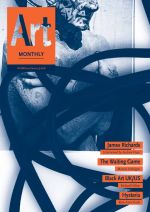From Black Art and the Harlem Renaissance to the Black Arts Movement and the Black Atlantic, to Black Power and back again. The UK’s most prestigious public art galleries are seemingly taking it in turns to present their blockbuster black art exhibition. Never has black art history had it so good. ‘Soul of a Nation: Art in the Age of Black Power’ at Tate Modern and ‘The Place is Here’ at Nottingham Contemporary (before travelling to South London Gallery and MIMA, Middlesbrough) are the latest exhibitions which in different ways fixate on narratives of the past. But do these exhibitions offer new insights and bring us any closer to really knowing the artists they profess to celebrate? Or, alternatively, are they symptomatic of the obligatory once-in-a-decade African-American exhibition or the black British survey? Are the politics behind these shows more significant than the politics within them? Does a fixation on black artists and the past reflect an institutional ruse for not dealing with black artists in the present?
‘Soul of a Nation’ is but the latest in a number of recent historical exhibitions which identify the 1960s as a significant period and starting point for reconsidering work by primarily African-American artists. It enters a field populated by other shows initiated and toured across the US, including the Walker Art Center’s exhibition ‘Radical Presence: Black Performance in Contemporary Art’ in Minneapolis in 2013, ‘The Freedom Principle: Experiments in Art and Music 1965 to Now’ at Chicago’s MCA in 2015 and, this year, ‘We Wanted a Revolution: Black Radical Women 1965- 85’ at the Brooklyn Museum in New York. Notably, ‘Soul of a Nation’ also comes hot on the heels of ‘Witness: Art and Civil Rights in the 1960s’, an earlier exhibition organised by the Brooklyn Museum in 2014. Staged to mark the 50th anniversary of the US’s Civil Rights Act of 1964, ‘Witness’, more than any other of the recent crop of exhibitions, anticipates these later shows, not least the crossover in themes and a similar line-up of artists, including Benny Andrews, Romare Bearden, Elizabeth Catlett, David Hammons, Jae Jarrell, Norman Lewis, Joe Outterbridge, Faith Ringgold, Betye Saar, Raymond Saunders, Andy Warhol and Charles White. ‘Witness’ also presented an interesting, if unexplored, conundrum about the delineation between civil rights and Black Power. For example, both ‘Witness’ and ‘Soul of a Nation’ use a painting by the late Barkley L Hendricks on their respective catalogue covers.
Significantly, however, ‘Witness’ was not a black survey exhibition. It included works by a significant number of white American and mainly male artists, such as Richard Avedon, Jim Dine, Robert Rauschenberg, Larry Rivers, Norman Rockwell and James Rosenquist, as well as a multi racial line-up of documentary photographers, such as Bruce Davidson, Charles Moore, Gordon Parks and Ernest C. Withers. Such an approach assumes particular significance given that ‘Soul of a Nation’ uses the ‘age of Black Power’ and the work of black artists as thematic binding agents. Also, instead of presenting a chronology of events, ‘Soul of a Nation’ was concerned with ‘different aesthetic strategies and debates circling around what it meant to be a black artist at the time’. Divided into 12 rooms, these strategies and debates focused on various artistic practices emerging in a number of cities, including New York, Chicago and Los Angeles. Such a curatorial armature appears useful as a way of defining what the curators considered to be characteristic narratives of the period, but problems arise when condensing over 70 artists and many more artworks from a 30-year period.
More +
Excerpt from Black Art UK/US Art Monthly 410: October 2017
Resonance FM 8 October 2017
Isobel Harbison
Richard Hylton
Maria Walsh
http://www.artmonthly.co.uk/magazine/site/events/isobel-harbison-richard-hylton-maria-walsh-talk-show-october-2017
